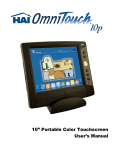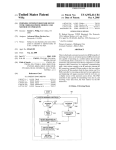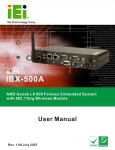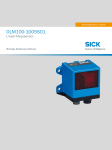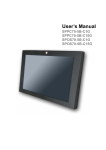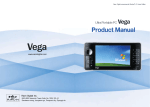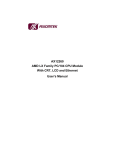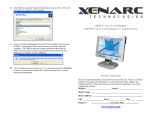Download User's Manual - EBN Technology Corp.
Transcript
User’s Manual POS50A-5B-LX800 POS50A-2B-LX800 POS50A-8B-LX800 PPC50A-5B-LX800 PPC50A-2B-LX800 PPC50A-8B-LX800 Copyrights communications. However, there is no guarantee ©2008 EBN Technology Corp. All rights reserved. The that interference will not occur in a particular information in this document is subject to change without installation. If this equipment does cause harmful prior notice in order to improve reliability, design and interference to radio or television reception, which function and does not represent a commitment on the can be determined by turning the equipment off and part of the manufacturer. on, the user is encouraged to try to correct the interference by one or more of the following This document contains proprietary information measures: protected by copyright. All rights are reserved. No • Increase the separation between the equipment part of this manual may be reproduced by any and the receiver. mechanical, electronic, or other means in any form • Connect the equipment into an outlet on a circuit without prior written permission of the manufacturer. different from that to which the receiver is connected. • Consult the dealer or an experienced radio or All trademarks are property of their respective television technician for help. owners This device complies with Part 15 (B) of the FCC Rules. Operation is subject to the following two Liability Disclaimer In no event will the manufacturer be liable for direct, indirect, special, incidental, or consequential damages arising out of the use or inability to use the product or documentation, even if advised of the possibility of such damages. Regulatory Information FCC Notices conditions: 1) this device may not cause harmful interference and 2) this device must accept any interference received, including interference that may cause undesired operation. NOTE: THE MANUFACTURER IS NOT RESPONSIBLE FOR ANY RADIO OR TV INTERFERENCE CAUSED BY UNAUTHORIZED MODIFICATIONS TO THIS DEVICE. SUCH MODIFICATIONS COULD VOID THE USER'S AUTHORITY TO OPERATE THE DEVICE. This equipment has been tested and found to comply CE Notice with the limits for a Class B digital device, pursuant to Part 15 of the Federal Communications Commission (FCC) Rules. These limits are designed to provide reasonable protection against harmful interference in This device complies with EMC Directive a residential installation. This equipment generates, 2004/108/EC issued by the Commission of the uses, and can radiate radio frequency energy and, if European Community. not installed and used in accordance with the instructions, may cause harmful interference to radio Copyrights i WEEE Notice The WEEE mark applies only to countries within the European Union (EU) and Norway. This appliance is labeled in accordance with European Directive 2002/96/EC concerning waste electrical and electronic equipment (WEEE). The Directive determines the framework for the return and recycling of used appliances as applicable throughout the European Union. This label is applied to various products to indicate that the product is not to be thrown away, but rather reclaimed upon end of life per this Directive. ii Contents Contents Copyrights .................................................................................................i Liability Disclaimer ...................................................................................i Regulatory Information.............................................................................i FCC Notices.......................................................................................................... i CE Notice .............................................................................................................. i WEEE Notice........................................................................................................ ii Contents...................................................................................................iii 1. Introduction ..........................................................................................1 2. Unpacking the Box...............................................................................2 POS50A-5B-LX800, POS50A-2B-LX800, POS50A-8B-LX800 ........................... 2 PPC50A-5B-LX800, PPC50A-2B-LX800, PPC50A-8B-LX800 ............................ 2 3. Hardware Setup....................................................................................3 3.1. Quick Tour .................................................................................................... 3 Front View...................................................................................................... 3 Back Panel I/O ............................................................................................... 3 3.2. Peripherals Installation................................................................................ 4 USB Mouse, USB Keyboard or USB ODD..................................................... 4 LAN Cable...................................................................................................... 4 Cash Drawer .................................................................................................. 4 MSR............................................................................................................... 5 3.3. Adjust View Angle (POS 50 series only)..................................................... 6 3.4. Turn on the Device ....................................................................................... 6 4. Driver and Utility Installation ..............................................................7 4.1. Before the installation.................................................................................. 7 4.2. TouchKit Utility Installation ......................................................................... 7 4.3. VGA Driver Installation ................................................................................ 9 4.4. Audio Driver Installation ............................................................................ 12 4.5. AES Driver Installation............................................................................... 14 5. TouchKit Utility Quick Guide.............................................................18 5.1. Launch Touchscreen V7.3.COM................................................................ 18 5.2. User interface ............................................................................................. 18 5.3. Serial Port Information .............................................................................. 19 5.4. Virtual Button Settings .............................................................................. 19 Virtual Button Option .................................................................................... 19 Right Button Function .................................................................................. 20 Right Button Automatic Mode....................................................................... 20 5.5. Feedback Sound ........................................................................................ 21 Feedback Sound Option .............................................................................. 21 Contents iii Tone ............................................................................................................. 22 Duration ....................................................................................................... 22 5.6. Screen Calibration ..................................................................................... 22 4 points, mode 1 .......................................................................................... 22 4 points, mode 2 .......................................................................................... 23 How to Use Event Selector .......................................................................... 24 6. I/O Definition.......................................................................................25 6.1. Power Connector ....................................................................................... 25 6.2. Serial Port ................................................................................................... 25 6.3. PS2/COM ..................................................................................................... 26 6.4. Cash Drawer ............................................................................................... 26 7. Specification.......................................................................................28 POS50A-5B-LX800 ............................................................................................ 28 POS50A-2B-LX800 ............................................................................................ 29 POS50A-8B-LX800 ............................................................................................ 30 POS50A-5B-LX800, POS50A-2B-LX800, POS50A-8B-LX800 ......................... 31 PPC50A-5B-LX800, PPC50A-2B-LX800, PPC50A-8B-LX800 .......................... 32 iv Contents 1. 1. Introduction Features: Chapter 1 AMD GeodeTM LX800 low power consumption and high performance technology Ultra-slim and light-weight chassis 2x USB 2.0, x RS-232 (COM 1/2: DB-9, RS-232, Pin 9w / RI / 5V / 12V selectable, COM 3: Internal for MSR) 10/100 Ethernet port (RJ-11) and cash drawer port (RJ-11) equipped Microsoft Windows series operation system (Windows XP Home Edition, Windows XP Professional Edition and WEPOS) and open-source Linux operation system supported. 1 2. 2. Unpacking the Box Verify that the box contains the following items. POS50A-5B-LX800, POS50A-2B-LX800, POS50A-8B-LX800 1 2 3 4 Device X 1 Power Adaptor X 1 Power Cord X 1 Driver and utility CD X 1 PPC50A-5B-LX800, PPC50A-2B-LX800, PPC50A-8B-LX800 1 2 3 4 5 6 Chapter 3 Device X 1 Power Adaptor X 1 Power Cord X 1 Wall mount Kit X 1 Screw package X 1 Driver and utility CD x 1 2 3. 3. Hardware Setup 3.1. Quick Tour Front View LED Indicator The Power indicator will glow green when power is on. The HDD indicator will blink green when the HDD is accessed. The LAN indicator will blink green when transferring data though the LAN. Back Panel I/O Note: For details of I/O ports on the back panel, please refer to Chapter 7 – I/O Definition. Chapter 3 3 3.2. Peripherals Installation USB Mouse, USB Keyboard or USB ODD Connect your USB Mouse, USB Keyboard or USB ODD to USB ports on the back panel of the device. LAN Cable Connect one end of RJ-45 LAN cable to the LAN port on the back panel of the device, another end to your internet device. Cash Drawer Connect one end of RJ-11 cable to the Cash Drawer port on the back panel of the device, another end to your cash drawer. 4 Chapter 3 MSR 1. Loosen and remove the four screws fixing the base unit by #1 Phillips screwdriver. 2. Remove the right hinge cover, left hinge cover and support cover as shown below. 3. Remove the base unit. 4. Connect the female connector of the external device to the PS2/COM port on the back panel of the device in the correct orient. Chapter 3 5 5. Align two screws of the MSR assembly to the holes and tighten two screws of the MSR assembly as shown below. 6. Reinstall right hinge cover, left hinge cover, support cover and base unit. 3.3. Adjust View Angle (POS 50 series only) Adjust the device to the proper view angle. 3.4. Turn on the Device 1. Make sure all peripherals are connected properly. 2. Press and hold the power switch until the power indicator on the front panel glow green. 6 Chapter 3 4. 4. Driver and Utility Installation 4.1. Before the installation All installation procedures described below are based on Microsoft Windows XP. 1. Connect an external USB CDROM drive to the USB port and insert the driver CD and turn on the device. The program autoruns and displays the DRIVER BANK screen. 2. Click POS50 /PPC50 /SBOXPC50/MobilePOS 50/SmartPOS 50 Series”. 4.2. TouchKit Utility Installation 1. Click “Touch Driver”. 2. Click “Touch Panel Driver for WINXP”. Chapter 4 7 3. Click “Next” button. 4. Click “Browse” to select the location where the driver installed, and then click “Next”. Or you can click “Next” go to next screen directly. 5. Click “Browse” to select the start menu folder, and then click “Next”. Or you can click “Next” go to next screen directly. 6. This screen displays setting information. Click Install to continue installation. If you would like to change settings, click Back to return to previous screens. 8 Chapter 4 7. During the installation, the following screen will be displayed. 8. The message below shows after the installation was successful. Click"OK" to complete the installation. 4.3. VGA Driver Installation 1. On Desktop, right click on the “Property”. My Computer icon and select 2. On the “System Properties” property sheet, select “Hardware” tab and click “Device Manager”. Chapter 4 9 3. On Device Manager, double click “Video Controller (VGA Compatible)”. 4. On the ” Video Controller (VGA Compatible)” property sheet, select “Driver” tab and click “Update Driver”. 5. On the welcome screen of Hardware Update Wizard, select “No, not this time”, and click ” Next”. 6. Select “Install from a list or specific location (Advance)”, and click “Next”. 10 Chapter 4 7. Click “Browse” to select the location where the driver installed, and then click “Next”. The location of the audio driver is: D:\Driver\Main Board Driver\VGA\AMD LX800\XP & XPe. 8. Click “Next”. 9. After installation completed, cluck “Finish”. Chapter 4 11 4.4. Audio Driver Installation 1. On Desktop, right click on the “Property”. My Computer icon and select 2. On the “System Properties” property sheet, select “Hardware” tab and click “Device Manager”. 3. On Device Manager, double click “Multimedia Audio Controller”. 12 Chapter 4 4. On the ”Multimedia Audio Controller Properties” property sheet, select “Driver” tab and click “Update Driver”. 5. On the welcome screen of Hardware Update Wizard, select “No, not this time”, and click Next. 6. Select “Install from a list or specific location (Advance)”, and click “Next”. 7. Click “Browse” to select the location where the driver installed, and then click “Next”. The location of the audio driver is: D:\Driver\Main Board Driver\Audio\GeodeLX Audio\GeodeLX_XP_XPe\WDM_Audio. Chapter 4 13 8. Click “Next”. 9. After installation completed, cluck “Finish”. 4.5. AES Driver Installation 1. On Desktop, right click on the “Property”. 14 My Computer icon and select Chapter 4 2. On the “System Properties” property sheet, select “Hardware” tab and click “Device Manager”. 3. On Device Manager, double click “Entertainment Encryption/Description Controller”. 4. On the ” “Entertainment Encryption/Description Controller Properties” property sheet, select “Driver” tab and click “Update Driver”. Chapter 4 15 5. On the welcome screen of Hardware Update Wizard, select “No, not this time”, and click Next. 6. Select “Install from a list or specific location (Advance)”, and click “Next”. 7. Click “Browse” to select the location where the driver installed, and then click “Next”. The location of the audio driver is: D:\Driver\Main Board Driver\Chipset\AMD LX800\Windows XP\GeodeLX_XP\WDM_AES. 8. Click “Next”. 16 Chapter 4 9. After installation completed, cluck “Finish”. Chapter 4 17 5. 5. TouchKit Utility Quick Guide 5.1. Launch Touchscreen V7.3.COM 1. Under Microsoft Windows XP, click “start” menu and select “Programs”, under ”Touchscreen V7.3.COM” menu, click “Touchscreen Control Panel V7.3.COM”, the control panel of the program shows. 5.2. User interface a b c d e f g h i 18 Serial Port Display serial port information of the system. Virtual Button Open the virtual button setting dialogue box. Feedback Sound Open the feedback sound setting dialogue box. Power Save Open the power down timer adjustment dialogue box Calibration Switch to calibration screen. Calibration Mode Menu Select the calibration by clicking this drop-down list. Support Display technical support information. Exit Exit the program. Enable right mouse button function. The default of this selector is with the left mouse button selected on. For details about event selector settings, please see “How to Use Event Selector” of Section 5.2. Event Selector Chapter 6 5.3. Serial Port Information Click Serial Port button, the serial port information shows. Click OK to back to the control panel. 5.4. Virtual Button Settings Click Virtual Button button, the dialogue box shows: The selected option will be in black. Virtual Button Option Under Virtual Button Option field, there are four options: ․Stream Mode Under this mode, all mouse button simulation will be disabled. ․Lift off Mode Under Lift off Mode, tapping and holding on the screen equals pressing and holding on the left button of the mouse. ․Touch Down Mode Under Touch Down Mode, one single-tapping equals one left mouse Chapter 6 19 clicking. ․Drag Drop Mode Drag Drop mode allows you to select an object on the screen by tapping, and then slide the selected object to a new location on the screen, the selected object will be dropped on the new location by releasing the touch. The selected option will be in black. Right Button Function ․Disabled (Off) Select this option, the event selector ․Enable (On) Select this option, the event selector the left-bottom corner of the screen. will be disabled and disappear. will be enabled and show on ․Automatic Mode/Manual Mode Drop-down List If the Drag Drop Mode under Virtual Button Option field is select, the drop-down menu below the Enable (On) option will be enabled. Automatic Mode - Select this option, the Right Button Function will switch to automatic will be disabled and disappear. mode and the event selector Manual Mode - Select this option, the Right Button Function will switch to manual mode and the event selector left-bottom corner of the screen. will be enabled and show on the - Options under Right Button Automatic Mode will be enabled when Manual Mode is selected. The selected option will be in black. Right Button Automatic Mode 20 Chapter 6 Toggle On time is the duration between the tapping on the screen and that the right mouse button is “virtually” pressed and held. Release the tapping from screen after toggle-on, the pop-up menu shows. The minimize value is 0.5 and maximum value is 5. This option defines how long the right button function will be off. The minimize value is 0.5 and maximum value is 5. Click the drop-down menu to select On or Off to enable or disable the beep sound effect for toggle-on and toggle off. 5.5. Feedback Sound Click Feedback Sound button, the dialogue box shows: Feedback Sound Option Silence (No Sound) Chapter 6 21 No any sound effect. Touch Down Only When this option is selected, there will be one “beep” sound when tapping on the screen. Lift Off Only When this option is selected, there will be one “beep” sound when releasing from the screen. Both Touch Down & Lift Off When this option is selected, there will be one “beep” sound when tapping on the screen and releasing from the screen. Tone Drag the bar to adjust the frequency of the sound effect. The minimize value is 200 and maximum value is 5000. Duration Drag the bar to adjust how long the “Beep” sound will be. The minimize value is 10 and maximum value is 50. The selected option will be in black. 5.6. Screen Calibration 1. Click the drop menu next to the Calibration button to select calibration mode. 4 points, mode 1 – rectangular four-point calibration 4 points, mode 2 – rhombic four-point calibration 2. Click Calibration button to enter the calibration screen. 4 points, mode 1 a. The mark shows on the Left-up corner. b. Follow the instruction in green to touch the center of Cross Mark. c. When the instruction turns into yellow, releasing the tapping from the screen. 22 Chapter 6 d. Follow the instruction in green to touch the center of Cross Mark. e. Repeat Step 2 – Step4 to finish the calibration procedure. 4 points, mode 2 a. The mark shows in the middle of the length of the screen.. b. Follow the instruction in green to touch the center of Cross Mark. c. When the instruction turns into yellow, releasing the tapping from the screen. d. Follow the instruction in green to touch the center of Cross Mark. e. Repeat Step 2 – Step4 to finish the calibration procedure. Chapter 6 23 3. When the calibration procedure is completed, the message shows: To save the new calibration, click Yes, to restore the old calibration, click No. How to Use Event Selector 1. On the desktop of Windows, click icon. 2. icon change to . 3. Now the tapping is simulating right mouse button clicking. 4. After one tap on the screen, icon change to 5. The tapping resumes to left mouse button clicking. 24 . Chapter 6 6. 6. I/O Definition Please refer the detailed technical information about all I/O ports as followings. 6.1. Power Connector PIN Description PIN Description 1 +12V 3 GROUND 2 +12V 4 GROUND 6.2. Serial Port COM Port 1/2/3/4 Chapter 7 PIN Description PIN Description 1 DCD 6 DSR 2 RXD 7 RTS 3 TXD 8 CTS 4 DTR 9 RI / 5V /12V 25 GND 5 NC 10 6.3. PS2/COM PS2/COM PIN Description PIN Description 1 6 PC_CLK )KEYBOARD) 11 CTS 2 GND +5V 7 KB_DAT 12 RTS 3 RXD 8 KB_CLK 13 DSR 4 TXD 9 RI / 5V /12V 14 DCD 5 PC_DAT (KEYBOARD) 10 DTR 15 KB_EN PIN Description 6.4. Cash Drawer Connector 26 PIN Description PIN Description 1 GND 4 12V 2 D_OUT 5 NC 3 D_IN 6 GND Chapter 7 Cash Drawer Control Chapter 7 Status Address Value Open 280H Bit 4 = 0 Close 280H Bit 4 = 1 Read Status 280H Bit 0 = 0/1 27 7. 7. Specification POS50A-5B-LX800 28 Chapter 8 POS50A-2B-LX800 Chapter 8 29 POS50A-8B-LX800 30 Chapter 8 POS50A-5B-LX800, POS50A-2B-LX800, POS50A-8B-LX800 Main Board CPU TM AMD Geode TM LX800 (500Mhz) Chipset AMD Geode System Memory SO-DIMM DDR 400, 128MB up to 1GB Thermal Solution Fan-less OS Microsoft Windows XP Professional, XPe, WEPOS, Windows CE, Linux LX800 + CS5536 Display TFT LCD Size 8.4” 12.1” 15” Brightness 200 nlts 220 nlts 350 nlts/250 nlts Resolution 800 X 600 800 X 600 1024 X 768 Touch Screen 5-wire Resistive Type Tilt Angle 17 O to 90O Storage Device DOM 1 X IDE 2.0mm 4” HDD 1 x IDE 2.5” Slime Type (Not for 8.4” model) Compact Flash 1 x Slot Compact Flash Type II I/O Ports USB 3x RS-232 COM 1/2: DB-9, RS-232, Pin 9w / RI / 5V / 12V selectable COM 3: Internal for MSR 2 x USB 2.0 LAN 1 x RJ45, 10/100 Base –T, supports wake on LAN PS2/COM 1 x internal for MSR, iButton Cash Drawer 1 x RJ11 (Power Pin 12V) Serial Others Power Supply External DC 12V Power Adapter (80W) Compliance FCC / CE Weight Dimension LX W X H 8.4” 12.1” 15” Approx. 3.2 Kg Approx. 4.6 Kg Approx. 5.9 Kg 232 X 234 X 292 232 X 313 X 335 232 X 370 X 369 o o Operation Temperature 5 ~ 40 C, Storage Temperature -20o ~ 60oC, Storage Humidity 20 – 85% RH, non-condensing . Chapter 8 31 PPC50A-5B-LX800, PPC50A-2B-LX800, PPC50A-8B-LX800 Main Board CPU TM AMD Geode TM LX800 (500Mhz) Chipset AMD Geode System Memory SO-DIMM DDR 400, 128MB up to 1GB Thermal Solution Fan-less OS Microsoft Windows XP Professional, XPe, WEPOS, Windows CE, Linux LX800 + CS5536 Display TFT LCD Size 8.4” 12.1” 15” Brightness 200 nlts 220 nlts 350 nlts/250 nlts Resolution 800 X 600 800 X 600 1024 X 768 Touch Screen 5-wire Resistive Type Storage Device DOM 1 X IDE 2.0mm 4” HDD 1 x IDE 2.5” Slime Type (Not for 8.4” model) Compact Flash 1 x Slot Compact Flash Type II I/O Ports USB 3x RS-232 COM 1/2: DB-9, RS-232, Pin 9w / RI / 5V / 12V selectable COM 3: Internal for MSR 2 x USB 2.0 LAN 1 x RJ45, 10/100 Base –T, supports wake on LAN PS2/COM 1 x internal for MSR, iButton Cash Drawer 1 x RJ11 (Power Pin 12V) Serial Others Power Supply External DC 12V Power Adapter (80W) Compliance FCC / CE Weight Dimension W X H X D 8.4” 12.1” 15” Approx. 1.2 Kg Approx 2.6 Kg Approx. 3.9 Kg 234 X 185 X 42 313 X 256 X 46.5 370 X 310 X 50.5 o o Operation Temperature 5 ~ 40 C, Storage Temperature -20o ~ 60oC, Storage Humidity 20 – 85% RH, non-condensing 32 Chapter 8









































